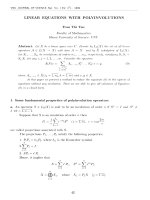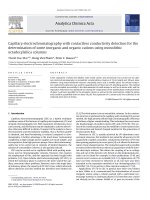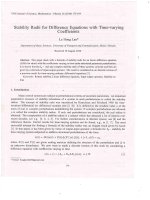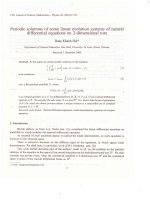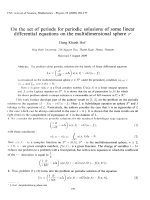DSpace at VNU: Linear equations with polyinvolutions
Bạn đang xem bản rút gọn của tài liệu. Xem và tải ngay bản đầy đủ của tài liệu tại đây (2.67 MB, 7 trang )
VNU JOURNAL OF SCIENCE. Nat, Sci,. t XV.
- 1999
L IN E A R E Q U A T IO N S W IT H
P O L Y IN V O L U T IO N S
T ia u T h i Tao
FHcuity o f MHthciiiHtics
Hanoi ưnivcTsity o f Scỉviìce- V N Ư
he (I l i n e a r s pace o v e r c . D e n o t e hy L q ( X )
A bstract.
I.et X
operators A
G L (X
—* .Y) Wifh d o m A =
X
m i d by X
L e t S i , . . . . 5,„ be i n v o l u i i o n s o f o r d e r s 7Í1 , . . . ,
t h e sef o f (ill !nie(ir
s u b a ỉ g eh r a o f L()( A) .
respectively, s a tisfy in g S , . S j ~
S j . S i for any } . j = 1 , 2 ......... ??/. ('onsider the equaiwn
. . . 5 ; ; r . r = ,v.
A{S).r=
(0)
k - 1,IM
e
w h er e
i/ ^
XỤị, —
I n t his p a p e r we p r e s e n t a m e t h o d to r ed uc e t h e e q u a t i o n ( 0 ) to t h e s y s t e m o f
equations without a n y involuHon.
T h e n w e are able to g i v e all soỉutiOTìs o f EquatìOìì
(0) in a close.d f o r w .
1. S o m e fu n d a m en tal p rop erties o f p o ly in v o lu t io n o p e r a to r s
a. An op erato r s G Lq { X) is said to bo an involution of onloi Ì) if .S'” “ / ami .S’^
I
= 1, / ; - 1.
Suppose th a t s is an involution of order 1 Ì then
P. — _ y
It
27T/
^
f = erp —
n
k= \
are callocl projections aysoc’iat(‘cl with
s.
The projections P i , . . . , p,, satisfy th e following proportios:
1. P j P j =
where
is the Kron ock or s y m b o l .
2 . ± r , = /,
.7=1
3. SPr
Hence, it implies th at
S = Y,^'Pr.
5"
ĩ=\
X = 0
Xj,
1=1
w h eio
A', = P j X
7=1
42
(j = Ty>).
L i n e a r E q u a t i o n s w i th P o l y i n v o l u t i o n s
43
b . Lot Si , . . . , Syji be co m m u tativ e involution operators of orders 77.1, . . . , respectively
and Pkj^Uk = 1,7/Ả:) be projections associated with Sk{k = l , m ) . We denote
k = l,m } ,
r ^ {(?■) = (il,
cim
oc(») _ CM
,
— Plji } •'-I Pmj„^ 1 1 ^
s '^'ki
A = { ( jz ,- ..,J r n )|P o ) 7 ^ 0 } ,
27T7
e
P ro p o sitio n .
a) ^
— eJ
VVe have the following relations
p „ , = I.
U)eA
^>) P{ i ) P{ 3) — ị
-f c \ _
I
0 A'(J)
cj ^ =
/
F(J)
{{i)\ =' U ) i k = jk V Ả := l,m )
i f (?:) =
0 );
where X(j) =
0)eA
Tlfc
Proof: a) From ^
= / VẲ: = 1, m an d the com m utativity of Pf^j^ we get
m
ntf.
k = i Jk = ĩ
j f c = T ^ (j)eA
fc= 1. rn
b) It n a t u r a l l y h o l d s b y the c o m m u t a t i v i t y a n d th.e a s s o c i a t i v i t y o f p r o j ec t io n s
c) It is im plied from a) and b)
□
2. T he equation (1) can be re w ritte n in th e from
=
A{S)x=
(1)
(•)€/
where A(.) =
We consider th e eq u atio n (1) under th e assumptions; V P(j), P(^),
G
A, ( 0 €
r, 3
where (j), (Ả:)
€ X satisfying
= ^{r)U)ik)P{k) (o rP (j)^ (,) =
A^)U)wPik))
(fc)€A
. 'f^0)^(«)0)(fc)'f’(í) = 0 V(/)
(k)
Acting on b o th sides of equ ation (1) by P(j), we obtain the system
(2)
TYan Thi Tao
44
Pu) E
{^)e^
= P(j)y
vơ) G A
Y1
^ P{])y V(j) e A
(t)er(Ẳ:)€A
E
E
V0 ' ) € A
=
(i)er{fc)€A
=> E
E
■4(.)o k * ) '''‘" ' ’’ (‘ ) = n , ) ! /
V(j) e A,
(3)
(r)€r(fc)6A
w h ere
3-(fc) = P(k)X € X(fc).
L enim a 1. ỉ f the condition (2) is satisfied, then the eqìiãtỉon (1) has a solution T e X if
and only i f sys tem (3) has a soiỉiủioíi (^(A:))(A:)eA ^
of (1) then (P{k)'^ĩ'){k)eA
Ỵ
(k)eA
^ioreover, if
T
is a solution
^ soiiitioii of (3) Hiid conversely, i f (j'(k)}(k)€A ^
^(A) is a
(*)€A
solution o f (3) then
X
= ^
j:(A:) is a sohition o f (1).
{k)eA
Proof: It is obvious t h a t if the equation (1) has a solution
is a solution of (3).
X
then from (3), {P{k)-^){k)eA
Con ver sely, s u p p o s e th a t t h e s y s t e m (3) has a s o lu ti o n (j^(A:))(ye)6A ^
We
(t)6A
prove that
X
=
^
is a solution of the equation (1).
{k)eA
Iiidet'd, since •'(it) t ^{k)
) t A (Iiicl ^ ( k ) ~
(fc)€A
= -Tịk)- FurtherrnoiP, i ^( k) ) { k) e^
V(J) € A,
5;
^ s o lu ti o n o f (3), which implies th at
= Pu)y
5;
{t)er{k)eA
(r)er(fc)€A
^
J2
(*)er(fc)€A
Y 1 ^ i ’){j)wP{k)S^' ^T = F(j)ị/
(i)e r(/c )6 A
^
= -^0 )^
(t)e r
^0) Z !
(j)eA
=> Y 1
(i)er
^ 0 )2^
(j)eA
Thus,
(fc)GA
is a solution of (1). Lem m a 1 is proved
Y.
(Oer
□
= y-
L i n e a r E q u a ti o n s w ith P o l y i n v o l u t i o n s
45
L e m m a 2. Suppose thnt the condi t i on (2) is satisfied. I f the system (3) has solutions
ãỉKÌ ( /■(ả-))(a-)€A ^
one its solution in the space
soliJtion of (3) in the space
then (Pạ-)-'ĩ'ik))(k)eA
^
(k)eA
Proof : L(*t (-T{k)){k-)eA ^
^ solution of system (3), i. e., v ( j ) 6 A
^(00)(A-)''**'^^’^-'>"(A-) = P u y y
(Oer (Ẳ-)€A
^
^
X]
(i)er(A :)eA
(0er(.)6A
= Puyy
{ i ) eA
(0.A^
jiV
(t)er(A-)eA
Y1 12
( kAc= ,\
Y1
(Ắ'}
( t ) €A
(Oer(A)eA
From Condition (2), it follows th at the left side of the last equality belongs to ker Pịj)
and Its light side belongs to
Note th a t Kor Pị^j) =
Xị,)
^
=> kerf(^) n.Y(^) ^
ij)
{ 0 } we get
^\ỉ)y ~ ^
X!
(0er(A-)6A
^ u
(0€r(Ẳ)€A
i.(\. (^^(A-Ị-í^íAOÌíẢìeA ^ solution of systoni (3) □
Combining two rosults just obtained yields ih(* following
T h e o r e m . Siipposc tiiHt Coiiditioli (2) is satisfied. The eqiiatioii (1) ÌÌH.S sohitioiis if and
only if the svstciii (3) Ììrìs soììitioĩi. Moreover, if .1' is H sobition o f (Ĩ) tiicn {P{k-)-^')(k ) e \
a solution o f (3) and coiiverscly, //"
^ soìĩìtion o f (3) then .1' = ^
{k-)eA
ri sollỉĩioỉi o f ( 1 ).
R e m a r k . I f *4(,) ((;) 6 r) are com m utative with the operators Sk- (A' — 1, 777) then the
system (3) becomes the iiKlepondont system
E
(Oer
= Puyy
VU) G A,
3. E x a m p l e s .
E x a m p l e 1 . Consider the Volterra - C arlem an integral equation of the form
IVtzn Thi Tao
16
ự:>(.r,y,t) ~ y
y
/
A',,(.7:./y. ^ r ) ^ [ f i , ( . r ) , / i , ( y ) ,
r]r/r
= !/(.r.Ịj,t).
(4)
\vh(‘i
1) g{.r. Ị/ , t ). K, i ( . v ,
Ịj,t,T)
aif' c o n t i n u o u s f u n c t i o n s V/ = 1, n,
2) a ( .r ) , f3{y) ai(' Ca r lp m a n t i a n s f o n n a t i o i i s o f or doi
a(A. + i)(.r) = a[QA.(.T)],QA-{.r) /
â ( k + i ) { y ) = d{ í h- { y) ] . f l k- { y) /
3)
y,t,T)
,T
ỉ/
if
if
V
J
= l, ? n.
a n d ni l e s p p c t i v r l y on
1 < Ả-< n,
Q„(:r) = ,r.
1 < A' < i n,
0 „ , { y ) = y.
R, i.e.,
a r e in v a r i a n t u n d e r t h o t r a n s f o r m a t i o n s a { . r ) , f3{y).
W e define the o p erators V , W , A j j E Loi-r) as follows:
{Vip){.r,yJ) = ự>a{.r),y,t
( U » ( . r , i/,0 = ự > \ x j 3 { y ) j ] ,
A,,^){x,y,f) =
/
K^j{x,yJ,T)ip{x,y,T)dT.
./0
Then the equation (4) can be rew ritten in the foini
n
v ,w
We note th a t
771
are com m utative involution o p e ra to rs of order
V and 7Ì1 respec
tively and the o perators A,J also com m ute w ith V, \V {i — 1, n , j — 1, m).
Denote by
—
l , n ) and
Qị^{ỊJ-
—
1, 77?) th e pro jection s associated with the V,
w
respectively.
From the above obtained results, in order to s tu d y of E q u a tio n (4), we can s tu d y
the system of the independent equations
-
/
M^f,{T,y,f,T)ip^,,{T,y,T)dT = g^f,{x,y,t)
V ;/=
1, n , / i = 1 ,7 » ,
If)
n
wheiT
rfi
1= 1 7=1
27T?
f i = e x p ------,
n
27T/
f2 = exp
rn
E x a m p l e 2; Consider th e Fredholm - Carleinari integral e q u atio n of form
n
2
ip{x
K^j { x, t , T) t f [ a^{. T) ,
Pj{T)]dr
= g{xj),
t = l j = l ‘' - i
where
1) g { x , y , t ) and K i j { x , t , r ) are continuous functions X e R ; t , r e [ - 1 , 1
2)
q (t )
is Carlem an transform ation of order n.
3 )/? (V --^
02Ìt) = m t ) )
= t^
We define th e operators V, w , Ai j as follows:
(5
L inear Equations w ith P o lyin vo lu tio n s
47
{Vip){x,t) =
{ Wự>) { x , f ) =
-t),
Ị
{A, j i p ) { x , i ) =
V?: = T7n; j =
K,j{x,f,T)^{x,r)dT,
1, 2.
T h en the e q u atio n (5) can be re w ritte n in the form:
We get
V/" = / ,
^
yịy ^
Denote by p ^ ( u = 1, 7?) the projections associated with V and
Qi = ị n - W ) ,
e = exp
Q^ = ụ i + W),
2ni
—
n
.
We prove th at the condition (2) is satisfied. Indeed, p uttin g
] ^
^
” k = l 1=1
then
f P l' Q s-^7 j p u Q r — ^ijiysf^rf^^Qr‘>
\ Pi/Qs ^ijusfir PoQi)
v.4,;(/ =
^ 1, 2)
and
V P^,P^(/v,/i
T h ( ' 1 ont IB t o n l i o w t h a t
1
^
"
—0
if
^
or
r; /
r
1,7?,) Q s . Q r { s . r = 1,2).
a iv tlir iiitcgiul o p c ia to iy . w\- have
“
rl
^
/
K , , [ n f , . { : T ) j 3i { t ) , T ] < f ị . r , 0 2 - l Ì T ) ] d T
” k = \ 1=1
Putting
Ơ = /32_ ;( r )
r = Pi{ơ),fÍT =
the light side OI
of rn
thee lasT
last eequality
q u a l ity ccan
a n aalso
lso be w rritten
i t t e n as
2n
'
P u tting
/
A-=l /-1
K,Aa,{x),m ,Pi{cTM x,a)da.
Tran Jhi Tao
48
We get
Thus, instead
id of studying the equation (5) we can stu d y the following onv
- Ẻ Ề Ê Ẻ i
i 1 1 (-
2= 1 J = 1 ^ = 1 r = l
A-=l i = l
X
(6)
X K i j { a k { x ) , l3 i ( f ) , P i { T ) ] i p ^ , r { : r , T ) d T
- P^Qsgi^J)
V i/= l , n ; s = 1, 2
Equation (5) has solutions if and only if the system (6 ) has solutions. Moreover, if
s=\
2
solutions of (6 ), then
TỈ
2
l/=l S=1
is a solution of (5).
REFERENCE
1] Nguven Van Mail. Generalized algebraic elernents and Linear singular infecral equa
tions with t r a n s f o r m e d arguments. Warsaw 1989.
2] D. P. Rolewicz. Equations in linear spaces. A m sterdam - Warsaw 1968.
3] D. P. Rolewicz. Algebraic Analysis. A m sterdam - Warsaw 1987.
T A P C H Í K H O A H O C D H Q G H N , K H T N , t.xv, n ^l - 1999
P H Ư Ơ N G T R ÌN H T U Y Ế N TÍN H V Ớ I CÁC T O Á N T Ử ĐA P H Ố l HỢP
Trần T h ị T ạo
Khoa Toán - Cơ - Tin bọc
Dại học Khoã học Tựnbièn - Đ H Q G HàNội
X là m ộ t khòrig g i a n t u y ế n t ín h trên t r ư ờ n g c . L o { X) là t ậ p tất cả rác t o á n tư
tuvến tính A trẻn X với dom i4 = X . X Ik đại số con của Lq{ X) . Giả sử 5 i , . . . , Sn, là
các toán tử đối hợp cấp r ?i , . . .
tư ơ n g ứng đòi một giao hoán với nhau.
Xét phương trình
t ^ —1, »1
fc=(l ,m)
trong đó
e X{ i k =
l,Tik,k
= l , m)
và x, y € X .
Nội dung của bài báo này là đ ư a phương trìn h (*) về hệ p h ư an g trình không còn
toán tử đối h ạ p m à tính giải đ ư ợ c của nó khả thi h ơ n nhiều, đồng thời cho mối liên hệ
giữa cấu trúc nghiệm của p h ư a n g trìn h (*) vái cấu trú c nghiệm của hệ đó.

